
Drasteria adumbrata, the shadowy arches, is a moth of the family Erebidae. The species was first described by Hans Hermann Behr in 1870. It is found from coast to coast in southern Canada, south in the west to California and Colorado, south in the east to New England and Michigan. Subspecies D. a. alleni is found from eastern Alberta to New York and Nova Scotia. Subspecies D. a. saxea occurs from southern British Columbia and south-west Alberta south to California and Colorado.
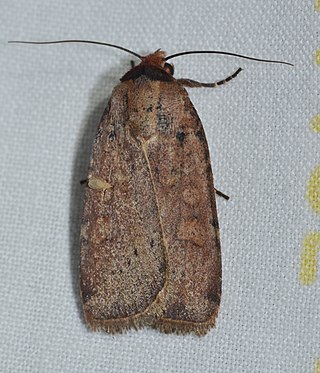
Protolampra brunneicollis, the brown-collared dart, is a moth of the family Noctuidae. The species was first described by Augustus Radcliffe Grote in 1864. It is found in eastern North America from New Brunswick to Alberta in southern Canada, and in the United States from Maine to North Carolina and Tennessee west to Mississippi, north to Minnesota, with scattered records in the west from North Dakota, South Dakota and Montana.
Euxoa aequalis is a moth of the family Noctuidae first described by Leon F. Harvey in 1876. It is found in Canada from British Columbia, Alberta, Saskatchewan and Yukon, south into the United States, where it has been recorded from Colorado, Wyoming and California.

Euxoa brevipennis is a moth of the family Noctuidae first described by Smith in 1888. In Canada, it is found in British Columbia, Alberta and Saskatchewan. In the United States, it has been recorded from Utah, Colorado and California.

Archips negundana, the larger boxelder leafroller, is a moth of the family Tortricidae. The species was first described by Harrison Gray Dyar Jr. in 1902. It is found in North America from southern British Columbia to southern Quebec, south to California and Florida.
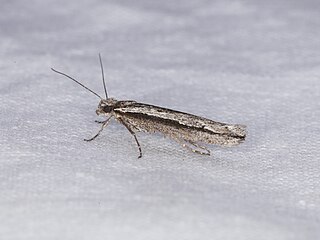
Ypsolopha flavistrigella is a moth of the family Ypsolophidae first described by August Busck in 1906. It was known only from the southern part of the United States, but has also been recorded from Alberta, Canada.
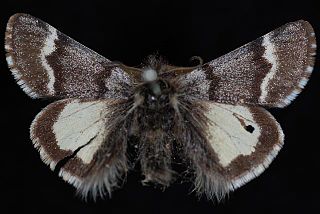
Leucobrephos brephoides, the scarce infant moth, is a moth of the family Geometridae. The species was first described by Francis Walker in 1857. It is found in North America from Yukon to Labrador and south to New York and southern Alberta and British Columbia. The habitat consists of open mixed wood forests of the boreal and mountain region.

Amblyptilia pica, the geranium plume moth, is a moth of the family Pterophoridae. The species was first described by Baron Walsingham in 1880. It is found in western North America from Alaska to California, inland to Alberta and Kansas. It is also found in the north-eastern United States and Ontario.
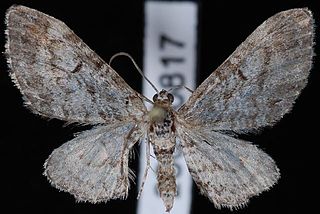
Eupithecia graefi, or Graef's pug, is a moth in the family Geometridae. The species was first described by George Duryea Hulst in 1896. It is found in North America from south-western Alberta west to Vancouver Island, north to Alaska and south to California. The habitat consists of wooded areas.
Crambidia impura is a moth of the family Erebidae. It was described by William Barnes and James Halliday McDunnough in 1913. There are two disjunct populations. It has been recorded from southern Rocky Mountain states, the Yukon and northern British Columbia and Alberta.
Archips alberta is a species of moth of the family Tortricidae first described by James Halliday McDunnough in 1923. It is found in North America, where it has been recorded across boreal Canada, south through the mountains to Utah. The habitat consists of coniferous forests.
Archips eleagnanus is a species of moth of the family Tortricidae first described by James Halliday McDunnough in 1923. It is found in North America, where it has been recorded from Alberta, Manitoba, Saskatchewan, Wyoming and New Mexico. The habitat consists of prairies and montane areas.

Parapoynx maculalis, the polymorphic pondweed moth, is a moth in the family Crambidae. It was described by James Brackenridge Clemens in 1860. It is found in eastern North America, where it has been recorded from Alabama, Alberta, Florida, Georgia, Illinois, Indiana, Louisiana, Maine, Maryland, Massachusetts, Michigan, Minnesota, Mississippi, New Brunswick, New Hampshire, New Jersey, Newfoundland, North Carolina, North Dakota, Nova Scotia, Ontario, Pennsylvania, Quebec, South Carolina, Tennessee, Texas and Wisconsin. The habitat consists of ponds and streams.
Petrophila kearfottalis is a moth in the family Crambidae first described by William Barnes and James Halliday McDunnough in 1917. It is found in North America, where it has been recorded from Alberta, Arizona, British Columbia, California, Colorado, Montana, New Mexico and Texas.

Catoptria oregonicus, the western catoptria or Oregon catoptria moth, is a moth in the family Crambidae. It was described by Augustus Radcliffe Grote in 1880. It is found in North America, where it has been recorded from British Columbia and Alberta to Montana, Oregon and northern coastal California. The habitat consists of meadows in the mountains and foothills.
Pediasia abnaki is a moth in the family Crambidae. It was described by Alexander Barrett Klots in 1942. It is found in North America, where it has been recorded from Maine, Michigan, Nova Scotia, Ohio, Alberta, Quebec, Ontario and New Brunswick. The habitat consists of grasslands. Adults have been recorded on wing from June to August.
Thaumatopsis fernaldella is a moth in the family Crambidae. It was described by William D. Kearfott in 1905. It is found in North America, where it has been recorded from Alberta, California, Florida, Maryland, Mississippi, Nevada, New Mexico, Oklahoma, Saskatchewan and Texas. The habitat consists of prairies.
Ostrinia marginalis is a moth in the family Crambidae. It was described by Francis Walker in 1866. It is found in North America, where it has been recorded from Newfoundland and Maine west to Alberta, the Northwest Territories and Yukon. The habitat consists of bogs and marshes.
Loxostegopsis polle is a moth in the family Crambidae. It was described by Harrison Gray Dyar Jr. in 1917. It is found in North America, where it has been recorded from Arizona, California, Nevada, New Mexico, Texas, Wyoming and Alberta. The habitat consist of short grass prairie. Adults have been recorded from May to June and in September.
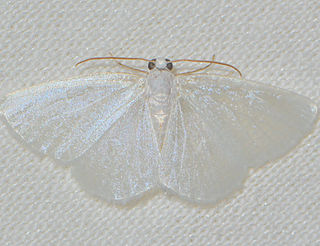
Lomographa vestaliata, the white spring moth, is a moth in the family Geometridae. The species was first described by Achille Guenée in 1857. Adults are diurnal and on wing in spring.










